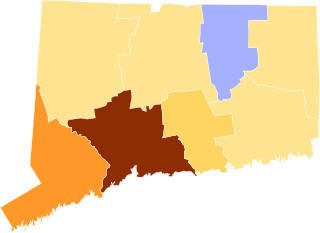
At a special judicial election on June 7, 1847, four judges of the New York Court of Appeals, the Clerk of the Court of Appeals, 32 justices of the new New York Supreme Court district benches, county judges, surrogates, district attorneys and all other judicial officers in the state of New York were elected, to take office on July 5, 1847.

The 1848–49 United States Senate elections were held on various dates in various states. As these U.S. Senate elections were prior to the ratification of the Seventeenth Amendment in 1913, senators were chosen by state legislatures. Senators were elected over a wide range of time throughout 1848 and 1849, and a seat may have been filled months late or remained vacant due to legislative deadlock. In these elections, terms were up for the senators in Class 3.

The 65th New York State Legislature, consisting of the New York State Senate and the New York State Assembly, met from January 4 to September 7, 1842, during the fourth year of William H. Seward's governorship, in Albany.

The 1860 Connecticut gubernatorial election was held on April 2, 1860. Incumbent governor and Republican nominee William Alfred Buckingham defeated former governor and Democratic nominee Thomas H. Seymour with 50.30% of the vote.

The 1858 Connecticut gubernatorial election was held on April 5, 1858. Former Norwich mayor and Republican nominee William Alfred Buckingham defeated former congressman and Democratic nominee James T. Pratt with 51.97% of the vote.

The 1856 Connecticut gubernatorial election was held on April 7, 1856. Incumbent governor and American Party nominee William T. Minor defeated former congressman and Democratic nominee Samuel Ingham and former Comptroller of Connecticut and Republican nominee Gideon Welles with 38.99% of the vote.

The 1853 Connecticut gubernatorial election was held on April 4, 1853. Incumbent governor and Democratic Party nominee Thomas H. Seymour defeated former state legislator and Whig nominee Henry Dutton and former state legislator and Free Soil nominee Francis Gillette with 51.01% of the vote.

The 1852 Connecticut gubernatorial election was held on April 5, 1852. Incumbent governor and Democratic Party nominee Thomas H. Seymour defeated incumbent Lieutenant Governor and Whig nominee Green Kendrick with 50.39% of the vote.

The 1848 Connecticut gubernatorial election was held on April 3, 1848. Incumbent Governor and Whig nominee Clark Bissell was re-elected, defeating former congressman and Democratic nominee George S. Catlin with 50.38% of the vote.

The 1846 Connecticut gubernatorial election was held on April 6, 1846. Former congressman and Democratic nominee Isaac Toucey was elected, defeating former state legislator and Whig nominee Clark Bissell with 47.54% of the vote.

The 1845 Connecticut gubernatorial election was held on April 7, 1845. Incumbent governor, Amistad lawyer and Whig nominee Roger Sherman Baldwin was re-elected, defeating former congressman and Democratic nominee Isaac Toucey with 51.00% of the vote.

The 1844 Connecticut gubernatorial election was held on April 1, 1844. Former state legislator, Amistad lawyer and Whig nominee Roger Sherman Baldwin was elected, defeating incumbent governor and Democratic nominee Chauncey Fitch Cleveland with 49.41% of the vote.

The 1843 Connecticut gubernatorial election was held on April 3, 1843. Incumbent governor and Democratic nominee Chauncey Fitch Cleveland was re-elected, defeating former state legislator, Amistad lawyer and Whig nominee Roger Sherman Baldwin with 50.13% of the vote.

The 1841 Connecticut gubernatorial election was held on April 5, 1841. Incumbent governor and Whig nominee William W. Ellsworth was re-elected, defeating businessman and Democratic nominee Francis H. Nicoll with 55.79% of the vote.

The 1839 Connecticut gubernatorial election was held on April 1, 1839. Incumbent governor and Whig nominee William W. Ellsworth was re-elected, defeating former senator and Democratic nominee John M. Niles with 51.52% of the vote.

The 1838 Connecticut gubernatorial election was held on April 2, 1838. Former congressman and Whig nominee William W. Ellsworth was elected, defeating former speaker of the Connecticut House of Representatives and Democratic nominee Seth Preston Beers with 54.14% of the vote.

The 1836 Connecticut gubernatorial election was held on April 4, 1836. Incumbent governor and Democratic nominee Henry W. Edwards was re-elected, defeating former governor, senator and Whig nominee Gideon Tomlinson with 53.93% of the vote.

The 1835 Connecticut gubernatorial election was held on April 6, 1835. It was a rematch of the 1834 Connecticut gubernatorial election. Former governor, senator and Democratic nominee Henry W. Edwards was elected, defeating incumbent governor and Whig nominee Samuel A. Foot with 52.13% of the vote.

The 1834 Connecticut gubernatorial election was held on April 7, 1834. Former senator and Whig nominee Samuel A. Foot was elected, defeating incumbent governor and Democratic nominee Henry W. Edwards with 49.83% of the vote.

The 1845–46 Massachusetts gubernatorial election consisted of an initial popular election held on November 10, 1845 that was followed by a legislative vote held on January 12, 1846. The ultimate task of electing the governor had been placed before the Massachusetts General Court because no candidate received the majority of the vote required for a candidate to be elected through the popular election. Incumbent Whig Governor George N. Briggs defeated Democratic nominee Isaac Davis, Liberty Party nominee Samuel E. Sewall and Know Nothing nominee Henry Shaw.























